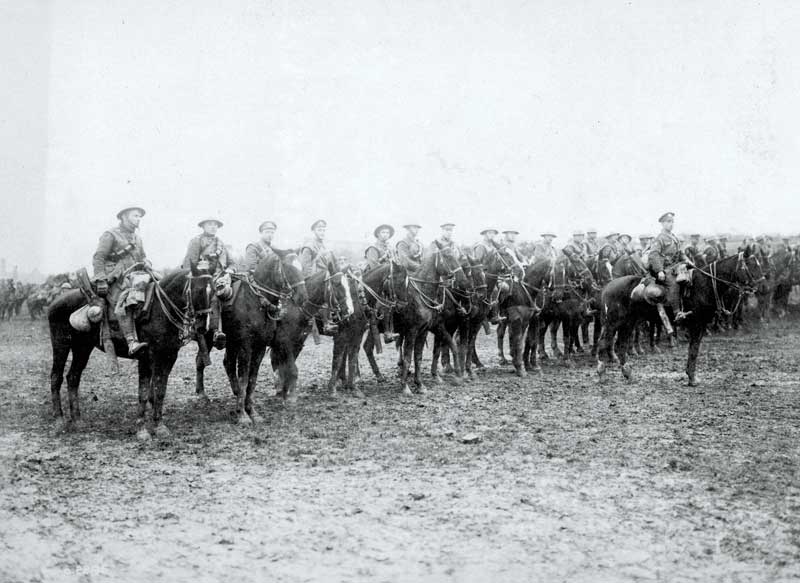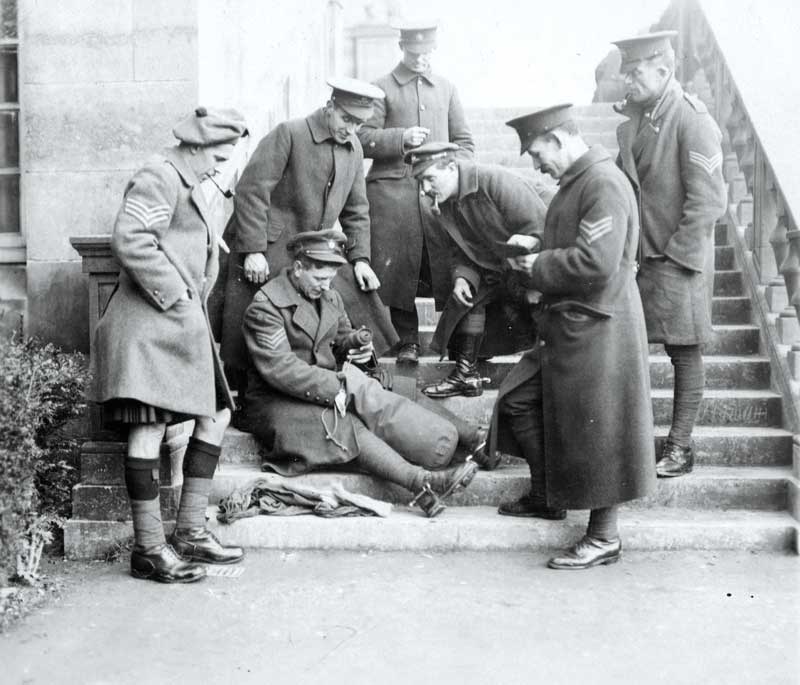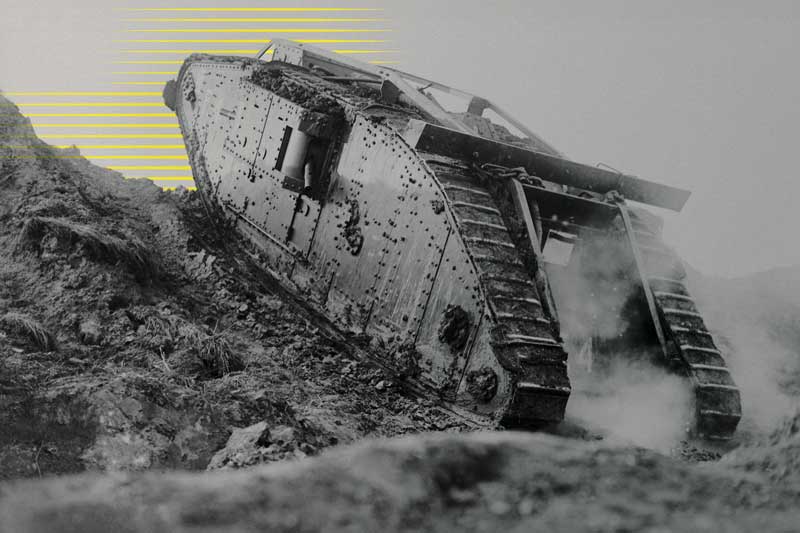
A newly developed Mark IV tank ascends a slope during special training for the Battle of Cambrai at the driving school in Wailly, where more than 400 tanks were gathered in northern France in October 1917. [Alamy/2HTXE09]
How the first Battle of Cambrai changed warfare forever
For three years into late-1917, Allied and German forces had been locked in a deadly stalemate, ensconced in trench works meandering more than 750 kilometres from the North Sea through parts of Belgium, France and Germany to the Swiss Alps.
Over the course of the Great War, some 60 million troops lived muddy rat-, lice- and disease-infested lives of misery, hardship and suffering punctuated by suicidal charges over the parapets under bone-shattering artillery strikes, through mazes of barbed wire and into storms of machine-gun bullets.
Bloody 1916 offensives at Verdun, which amassed 700,000 casualties on all sides, and the Somme, with more than a million, along with nearly 500,000 killed, wounded, missing or captured at Passchendaele in 1917, had yielded precious few rewards—or, it seemed, lessons.
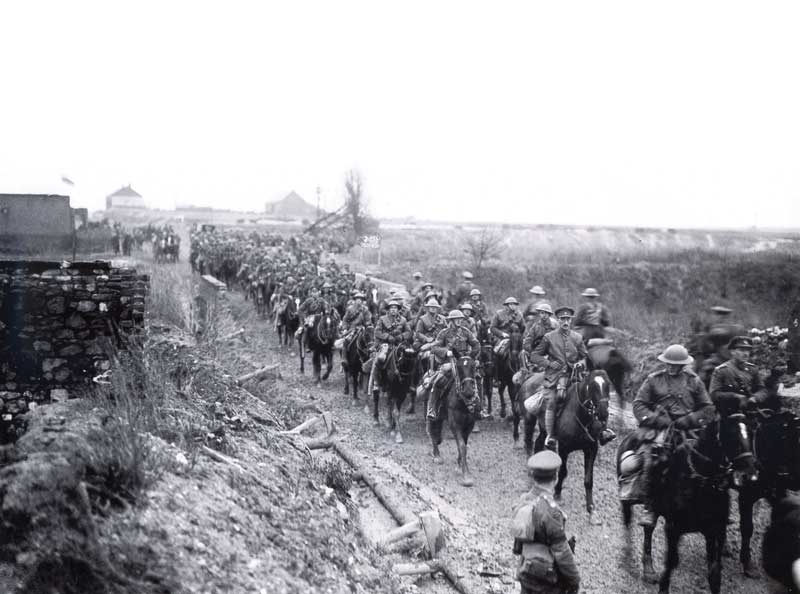
A squadron of the Fort Garry Horse passes through a village on the Cambrai front in December 1917.[LAC/3405685]
The Battle of Cambrai in November and December 1917 marked the Allies’ most innovative offensive to date, incorporating methods, technologies and troops on an unprecedented scale to unprecedented effect—at least initially. It consolidated many of the advancements Allied forces had developed through trial, error and measured success during 39 months of carnage.
Though it produced no lasting victory and cost more than 70,000 Allied casualties—almost 40 per cent more than the German defenders—the integrated attack helped set the stage for the conclusive Hundred Days Offensive of 1918. It was dubbed “The Great Experiment,” and it cost Canada 1,052 men, Newfoundland 447.
Cambrai was chosen as the Allied objective partly due to its role as an important German rail and supply hub and because the landscape was dry and undisturbed by prior battles, thus lending itself to the use of Britain’s latest Mark IV tanks.

A British tank is targeted by German gunners at Cambrai in November 1917. [Sueddeutsche Zeitung Photo/Alamy/E003E9]
British forces deployed 476 of the lumbering, eight-man, 28.4-tonne behemoths at Cambrai, 378 of them in combat roles. That was more tanks than in any battle since 32 Mark Is were first used at Flers-Courcelette on the Somme. Most of those had succumbed to breakdowns, debilitating mud or, to a lesser degree, enemy fire.
At Cambrai, which posed a layered defence, Brigadier-General Henry Tudor, commander of the 9th (Scottish) Division artillery, advocated new methods of combined arms, including surprise artillery strikes ranged by pinpointing enemy co-ordinates through surveys of German positions and the sounds of their gunfire.
These replaced the traditional ranging of enemy positions by fire alone—bracketing, etc.—which inevitably warned the enemy of impending barrages and subsequent infantry attacks.
British General Julian Byng, credited with the novel planning and training methods that led to Canada’s seminal victory at Vimy Ridge, embraced the suggestions at Cambrai, turning what was initially intended as a raid into an all-out offensive 40 kilometres from the Belgian border.
For two weeks leading up to the battle, the Royal Flying Corps had trained its pilots in air-to-ground tactics, which 300 aircraft brought to bear on trenches, supply points and enemy airfields in the days leading up to the ground offensive.
At dawn on Nov. 20, 1917, members of the Newfoundland Regiment waited while 110,000 infantry launched the attack. True to the times, it was raining.
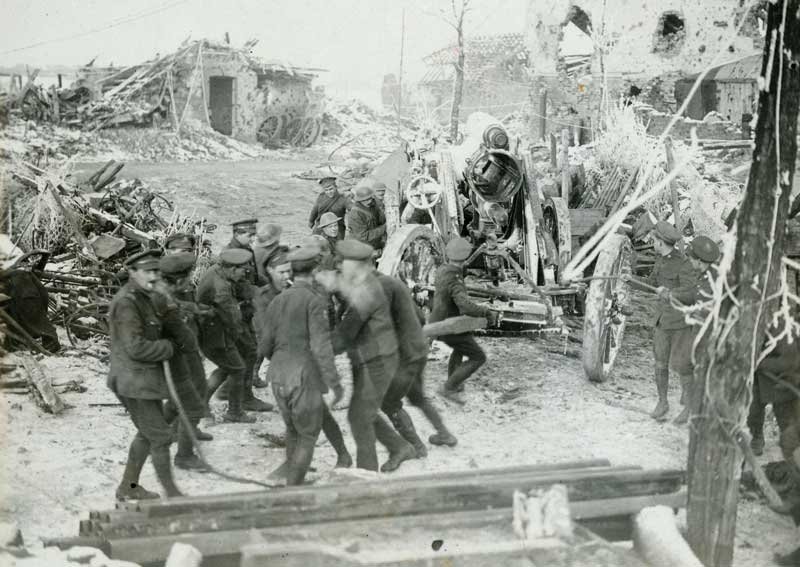
Canadian artillerymen move a howitzer into position amid the ruins of a French village.[LAC/CWM/19930013-603]
The tanks crushed barbed wire 15 metres deep; the same job would have taken weeks in a traditional attack.
In what has been described as a forerunner of the blitzkrieg tactics of Hitler’s Second World War offensives, 1,003 artillery pieces opened fire across a 16-kilometre front, laying down a creeping barrage 270 metres in front of six infantry and two cavalry divisions, along with nine tank battalions, as they advanced.
The troopers of the Canadian Cavalry Brigade, part of five horsed cavalry divisions, also waited. Finally, at about 10 a.m., the Newfoundlanders—17 officers and 536 enlisted men—began pressing northeast with other units of the 88th Brigade. They moved in diamond formation behind a clattering line of tanks near Villers-Plouich.
The Essex Regiment led the way; the Newfoundlanders were on the left, the Worcestershire Regiment on the right, the Hampshires took up the rear.
Coming off a brutal ordeal at Ypres, the Newfoundlanders met little resistance as they crossed the first trenches of the Hindenburg Line. Enemy machine guns felled some troops and slowed the advance before the nests were destroyed.

Men of the Fort Garry Horse who took part in the famous charge at Cambrai, which was described by New York’s The Evening World as equal to “anything in cavalry exploits in the history of the British Empire.[LAC/CWM/19930013-572]
The tanks crushed barbed wire 15 metres deep; the same job would have taken weeks in a traditional attack. But German artillery would knock out three of the four tanks attached to the brigade. The fourth was sidelined by engine trouble.
Major Richard Foot described those first successes as “a day to be remembered. We really had the sense of victory.”
Elsewhere along the line, Lance-Corporal Alfred Brisco’s battle inside a tank named “Hotspur” came to a sudden and violent end.
“There was a terrific roar and Hotspur shuddered from stem to stern,” Brisco recalled afterward. “I saw our left cater-pillar track fly in the air.
“Our left nose was blown off. If that last shell had landed two feet closer the officer and I would most certainly have both been killed.”
A nearby tank to the right received a direct hit and burst into flames.
“I only saw one man roll out of a side door,” said Brisco. “The tank on our left also had a direct hit. I did not see anyone get out of that.”
Still, the infantry pressed forward. German defenders were overwhelmed. Allied soldiers even described it as a “picnic” and a “cakewalk.” In his memoirs, Major Richard Foot of the Royal Field Artillery described those first successes as “a day to be remembered. We really had the sense of victory for the first time.”
Nevertheless, there was savage fighting across the front. British Major William Watson described the scene as he approached a defeated German trench.
“The trench-boards were slippery with blood and 15 to 20 corpses, all Germans and all bayoneted, lay strewn about the road like drunken men,” he recalled.
“A Highland sergeant … who was in charge of the place, came out to greet us puffing a long cigar.”
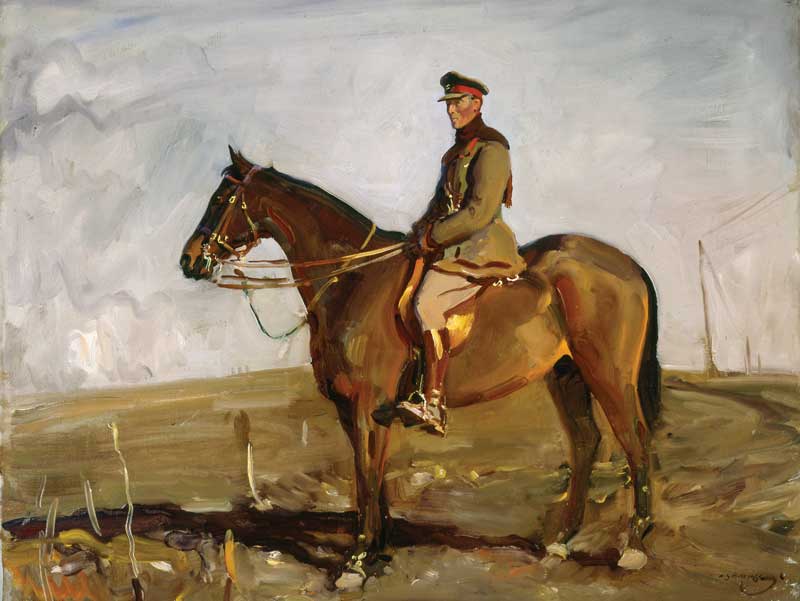
The Canadian Cavalry Brigade commander was Brigadier-General John Seely, a master horseman and British MP who quit Parliament to fight. [CWM/19710261-0450]
The Newfoundlanders captured prisoners as they progressed, finally reaching the slope to the St. Quentin Canal, 1,000 metres ahead. Marcoing was to the left, Masnières to the right. The attackers moved into position to launch an assault across a canal lock into the unsecured village of the latter.
Here, German defences had been strengthened and the canal approaches were well covered by snipers and machine guns. A tank was called up and, while it pounded the enemy on the north bank, the Newfoundlanders scurried over, led by Captain Grant Patterson, who would be awarded a Military Cross.
The regiment sheltered in buildings along the canal and prepared to make a 55-metre dash to a parallel railway line. A German machine gun stalled several attempts before Captain Bert Butler and his men reached the tracks and silenced the weapon, earning Butler a Distinguished Service Order.
Marcoing was free of Germans, but Masnières wasn’t. The attackers’ armour was stalled at Masnières after the bridge was damaged by retreating Germans. The weight of the lead Allied tank, “Flying Fox II,” finished the job, and it fell with the collapsing span into the canal.
The Newfoundlanders took a right turn toward the village, but spent the rest of the day eliminating pesky machine guns and bivouacked near the bridge on the village outskirts, dispatching parties to mop up through the night.
By the time the Newfoundlanders were relieved two days later, they had lost 10 officers and 238 enlisted men.
Cambrai was to be the first battle in which tanks and cavalry were used in concert, historian Stephanie E. Potter wrote in 2013.
Although Field Marshal Douglas Haig had ordered cavalry corps commander Charles Kavanagh to begin training the mounted troopers in collaborative warfare on Sept. 24, “no combined arms training between cavalry and tanks took place prior to the Cambrai offensive,” noted Potter.
“Furthermore, doctrine for the combined use of both cavalry and tanks in battle was still in its infancy.”
She said the cavalry was expected to use its superior mobility to pass through the gap created by the tanks and infantry, then surround the villages or enemy flanks while tanks performed a frontal assault.
But tanks of the day had some serious limitations: they were slow, and their high fuel consumption limited their range; they got easily stuck, were mechanically unreliable and were too big to move along streets or through heavily wooded areas.
“Cavalry,” said Potter, “was expected to advance where tanks could not.”
Realistic objectives for such operations had been set in March 1917, but in final planning for the expanding offensive at Cambrai, ambitions exceeded reality.
All five British cavalry divisions were sent to the front to join the attack, but only three saw action on the first day.
Private Chris Knight of the 2nd Dragoon Guards described the scene at the rendezvous point where the cavalry gathered en masse in the hours before the first waves of tanks and infantry launched the attack.
“I had never seen so many horses and men together at one parade. It was an awe-inspiring sight,” Knight recalled. “Dragoons, Lancers, Hussars—they were all there, as well as Indian mounted troops. The ‘saddle-up’ went for an Indian brigade first.
“We sat tense in our saddles, waiting for the order to go forward. Everybody was ‘keyed up.’ Would the order ever come?”
He was barely 20 years old, “very young indeed to be a cavalryman.” There were men in his troop who had campaigned in South Africa some 17 years earlier.
“There I sat astride a powerful bay, wondering whether he would keep his feet in the plunge that was to come, or whether he would fall in the morass: whether we should both come back triumphant or whether I should come back carrying my saddle. It never occurred to me that I should not come back.”
Knight did come back—13 months later. He was captured on the second day of fighting and ended up in Germany until the war ended.

Lieutenant Harcus Strachan (above) was awarded the VC for his “outstanding gallantry and fearless leading” during the battle. [CWM/19710261-0411]
The Canadian Cavalry Brigade served as the advance guard for the eastern approach to Masnières. Comms issues plagued cavalry operations and, under the impression the bridge was intact, and tanks had crossed the canal, the Fort Garry Horse went in, only to find the bridge lying in a tangled mass in the canal.
Major Philip Hammond of “F” Battalion Tank Corps, evidently not a fan of equestrian warfare, witnessed the ensuing confusion, describing it as “the most ludicrous thing.”
“There was a great deal of clattering, galloping and shouting and a lot of our medieval horse soldiers came charging down the street,” Hammond said later. “I yelled at them that the bridge was gone but they took no notice of me and went right up to it—one [machine gun] would have wiped out the lot, and then they turned about and with a very pious air trotted back the way they had come.”
The Winnipeg-based horsemen were now stalled.
The Canadian Cavalry Brigade commander was Brigadier-General John Seely, a British MP who quit Parliament to fight and led one of history’s last great cavalry charges at the 1918 Battle of Moreuil Wood. He had an innate understanding of warhorses, their capabilities and their limitations.
“Horses can cross almost anything, they can even swim broad rivers, as they have often done in war,” he said. “But the one thing that they cannot get over, unless they can bridge it, is a canal with perpendicular banks.
“They can get in but they can’t get out.”
While a patrol was off reconnoitering an alternate canal crossing, the Fort Garrys’ commanding officer, Lieutenant-Colonel Robert Paterson, found a stash of large timbers, each more than 20 centimetres wide by some seven metres long.
Local residents helped them build two temporary bridges, 2.5 metres wide apiece—16 timbers across the six-metre-wide canal. The civilians also provided tools, including ropes and axes. The lock keeper donated doors from inside his home for bridge decks. The spans took 75 minutes to build, with enemy fire providing extra incentive to get the job done in a jiffy. It was 3 p.m.
Strachan sent the remaining horses forward as decoys while the men made their escape.
After a single rider and horse tested the new construction, Captain Duncan Campbell led the Fort Garrys’ “B” Squadron across. It took them seven minutes under constant enemy harassment. Several riders fell into the canal and drowned.
The rest of the regiment was to follow but, with only 90 minutes of light left and no opportunity to send reinforcements, a message came forward to Paterson to muster his troops, withdraw and rejoin the rest of the brigade.
“Paterson sent the dispatch rider ahead to communicate these orders to ‘B’ Squadron,” Potter wrote. “However, the rider and Paterson himself were unable to catch up with ‘B’ Squadron, which had advanced at a gallop.”
The squadron was proceeding on orders to capture the enemy corps headquarters at Escaudœuvres, scout a new crossing farther along the canal and report on the status of bridges.
The advance was going smoothly until they approached Masnières, where machine guns forced them to turn north. They cut a large hole in the wire at Masnières-Beaurevoir before Campbell and two others were killed.
Lieutenant Harcus Strachan assumed command and, under ongoing fire, continued leading the troopers through the wire a few at a time. Finally able to advance in column formation, they encountered a German field battery, equipped with four 77mm guns. The cavalry unit charged and killed or captured the entire crew.
“The capture of these guns had been a great help to those in the rear as the shellfire round the bridge had been caused by them,” Strachan recounted.
But the 120-member squadron was now just 43 troopers. The survivors regrouped and Strachan ordered them to chase down the scattered and retreating enemy infantry, who were making for gun pits less than 750 metres east of Rumilly.
The pursuers came under heavy machine-gun fire and were forced to take shelter in a sunken road about a kilometre east of the village. Night was falling, and it was evident that no reinforcements were en route.
Strachan sent the remaining horses forward as decoys while the men made their escape. They sent their mounts stampeding from their position while the troopers ran back toward Masnières. Ten were shot down on the return through enemy-occupied territory.
Criticized by some of his own men for reckless actions with a depleted force, Strachan was nevertheless awarded a Victoria Cross for his actions that day.
The Allies had broken the German front line, capturing 7,500 prisoners, liberating several villages and advancing eight kilometres across the vaunted Hindenburg Line—
farther in a matter of hours than in three months at Passchendaele.
Church bells were permitted to ring in London in a rare exception to a wartime ban on the practice.
“This is one of the great victories of the campaign, splendidly conceived and splendidly won, a fitting occasion for the ringing of the joy-bells which have for so long been silent,” reported the Army and Navy Gazette of the battle’s first day.
But the day was a costly success: 179 tanks had been taken out of action; 65 were destroyed, 71 were disabled by mechanical failure and 43 were stuck. The Allies suffered some 4,000 dead and wounded; 4,200 were taken prisoner.
In an essay for the Western Front Association, David Tattersfield attributed the ease of the first day’s success in part to overconfidence on the German side.
“The line at Cambrai was under-manned, and was held by tired or second-rate troops,” he wrote, noting the German command assumed that a lengthy preliminary barrage would give them ample time to reinforce their defences.
As it turned out, the offensive simply lost momentum and was perpetuated long after any hope of success had vanished.
“In spite of the great success near Cambrai, final victory is not definitely in sight,” the Huddersfield Daily Examiner reported on Nov. 23, 1917, “and it appears to us that the time for the ringing of joy bells has not yet arrived.”
By Nov. 28, Allied troops held a salient on the crest of Bourlon Ridge. Two days later, German forces launched a counteroffensive, laying down heavy artillery fire and dispatching infiltrating storm troopers in intense fighting.
The Newfoundland Regiment was on the move on Nov. 30, approaching Marcoing Copse when they encountered advancing Germans trying to outflank the 29th Division. The Newfoundlanders attacked with bayonets, stemming the enemy advance. They were relieved on Dec. 3 after enduring several days of virtual round-the-clock bombardment.
Allied forces retreated from the salient, leaving them with meagre gains.
“For the British, however, it felt like a defeat,” wrote Gary Sheffield in The Chief, his 2011 biography of Haig. “The initial euphoria at the achievements of 20 November gave way to bitter disappointment. This did more damage to Haig’s reputation than even the losses and struggles at Ypres.”
The Battle of Cambrai ultimately had little strategic impact. Yet the tactics used by both sides pointed the way to more sophisticated warfare.
It also marked something of a last great hurrah for horse-borne fighting. Hamstrung by poor communication and an overly complex command chain, the cavalry never lived up to expectations.
“After the Battle of Cambrai, cavalry was written off as an antiquated and medieval arm that did nothing but sit behind the front lines, taking up road space that could be better used by supply trains,” wrote Potter.
The consensus among historians is that Cambrai was poorly planned. Objectives were unrealistic; the actions were not well co-ordinated; and preparations for an enemy counterattack were inadequate.
“The Cambrai offensive seemed unlikely to succeed before planning had even begun,” said Potter. “Launching a campaign so late in the year was a tactical error on Haig’s behalf, particularly after the long and exhausting Ypres campaign.
“The operation proceeded despite a lack of manpower and no reserve, as British reinforcements had been sent to the Italian front.”
Yet they were the same tactics that shattered German defences in 1918, Bryn Hammond, head of collections at the Imperial War Museum, told the BBC in 2017.
“It was a landmark in warfare,” said Hammond. “It establishes the principle of surprise attack, using each weapon in the role for which it is best suited, still used in the Gulf War.
“The era where the deadly combination of machine guns, barbed wire, artillery and trenches defined the character of the battlefield was over.”
The second Battle of Cambrai in October 1918 would prove a pivotal success at the outset of the Hundred Days campaign that ultimately ended the war to end all wars.
Advertisement







